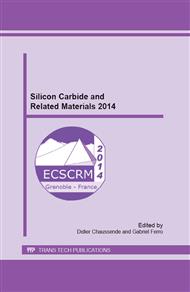[1]
J. Rabkowski, D. Peftitsis, H.P. Nee, Silicon Carbide Power Transistors: A New Era in Power Electronics Is Initiated, Industrial Electronics Magazine, IEEE 6 (2012) 17-26.
DOI: 10.1109/mie.2012.2193291
Google Scholar
[2]
N. G. Wright, A. B. Horsfall, and K. Vassilevski, Prospects for SiC electronics and sensors, Materials Today, 11(1-2) (2008) 16-21.
DOI: 10.1016/s1369-7021(07)70348-6
Google Scholar
[3]
Information on http: /www. cree. com.
Google Scholar
[4]
K.V. Vassilevski, N.G. Wright, I.P. Nikitina, A.B. Horsfall, A. O'Neill, M. Uren, K. Hilton, A. Masterton, A. Hydes, C.M. Johnson, Protection of selectively implanted and patterned silicon carbide surfaces with graphite capping layer during post-implantation annealing, Semicond. Science and Techn. 20 (2005).
DOI: 10.1088/0268-1242/20/3/003
Google Scholar
[5]
A. Hallén, R. Nipoti, S. E. Saddow, S. Rao, and B. G. Svensson, Advances in Selective Doping of SiC Via Ion Implantation, in: S. E. Saddow and A. Agarwal (Eds. ), Advances in Silicon Carbide Processing and Applications, Artech House, 2004, pp.109-153.
DOI: 10.1186/1475-925x-4-33
Google Scholar
[6]
I. P. Nikitina, K. V. Vassilevski, N. G. Wright, A. B. Horsfall, A. G. Oneill, and C. M. Johnson, Formation and role of graphite and nickel silicide in nickel based ohmic contacts to n-type silicon carbide, J. Appl. Phys. 97 (2005) 083709.
DOI: 10.1063/1.1872200
Google Scholar
[7]
I. P. Nikitina, K. V. Vassilevski, A. B. Horsfall, N. G. Wright, A. G. O'Neill, C. M. Johnson, T. Yamamoto, and R. K. Malhan, Structural pattern formation in titanium-nickel contacts on silicon carbide following high-temperature annealing, Semicond. Science and Techn. 21 (2006).
DOI: 10.1088/0268-1242/21/7/013
Google Scholar
[8]
K. V. Vassilevski, G. Constantinidis, N. Papanicolaou, N. Martin, and K. Zekentes, Study of annealing conditions on the formation of ohmic contacts on p+ 4H-SiC layers grown by CVD and LPE, Materials Science and Engineering B 61-2 (1999) 296-300.
DOI: 10.1016/s0921-5107(98)00521-2
Google Scholar
[9]
M. Laube, F. Schmid, G. Pensl, G. Wagner, M. Linnarsson, and M. Maier, Electrical activation of high concentrations of N+ and P+ ions implanted into 4H–SiC, J. Applied Phys. 92 (2002) 549.
DOI: 10.1063/1.1479462
Google Scholar
[10]
F. Schmid, G. Pensl, Comparison of the electrical activation of P+ and N+ ions co-implanted along with Si+ or C+ ions into 4H-SiC, Appl. Phys. Lett. 84 (2004) 3064-3066.
DOI: 10.1063/1.1707220
Google Scholar
[11]
D. Dwight, M. V. Rao, O.W. Holland, G. Kelner, P.H. Chi, J. Kretchmer, M. Ghezzo, Nitrogen and aluminum implantation in high resistivity silicon carbide, J. Appl. Phys. 82 (1997) 5327-5333.
DOI: 10.1063/1.366299
Google Scholar
[12]
M. Roschke, F. Schwierz, Electron Mobility Models for 4H, 6H, and 3C SiC, IEEE trans. ED 48 (2001) 1442.
DOI: 10.1109/16.930664
Google Scholar


